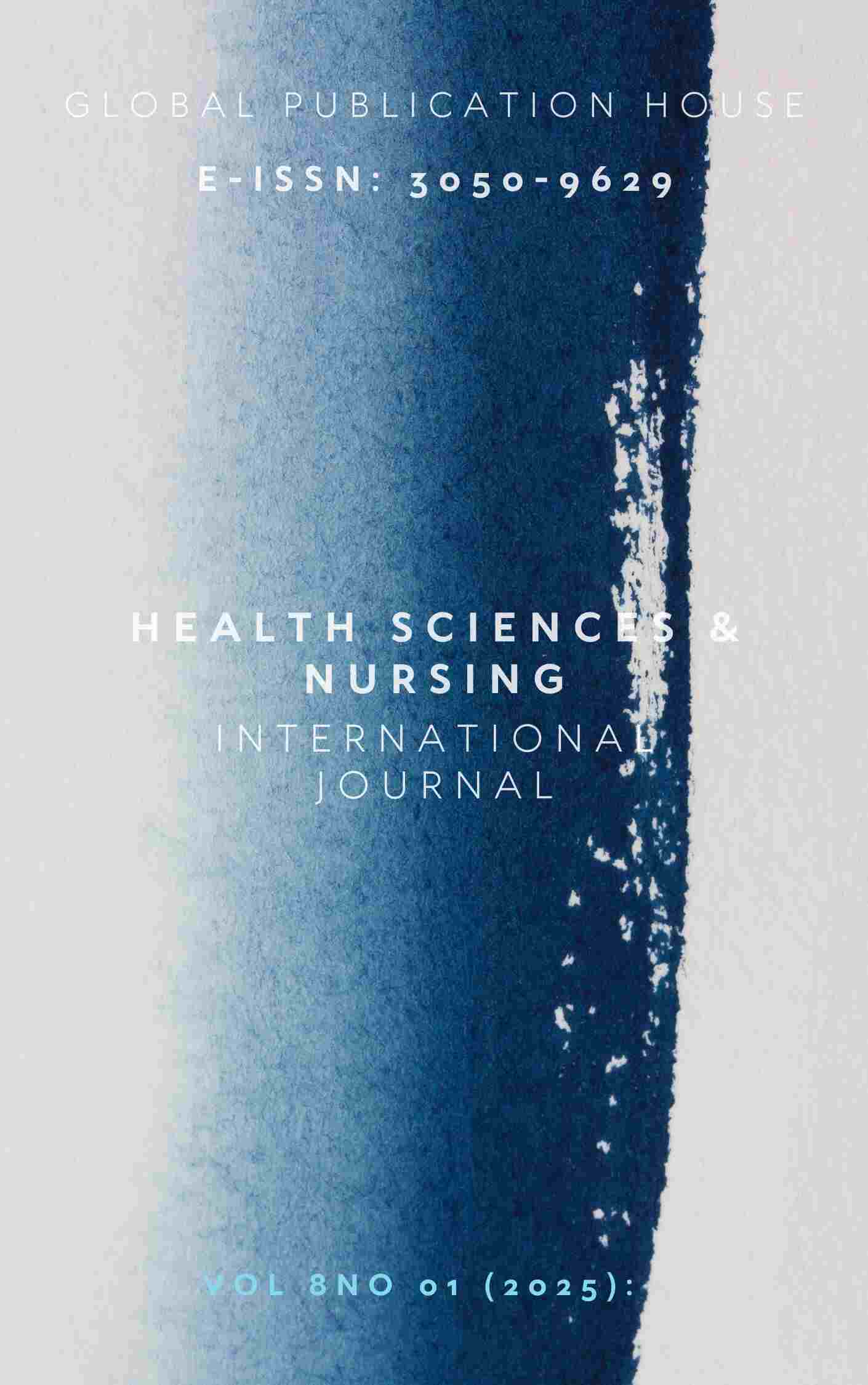Maternal Knowledge About Severe Acute Malnutrition Under Five Years of Children at Sher E Bangla Medical College and Hospital, Barishal, Bangladesh
Abstract
Malnutrition remains a critical public health issue, particularly in low- and middle-income countries (LMICs), contributing to over 50% of under-five mortality. Severe acute malnutrition (SAM) affects millions of children, leading to life-threatening complications and long-term developmental impairments. Maternal knowledge plays a pivotal role in preventing and managing SAM, yet gaps persist in awareness and healthcare access. This study assessed mothers' knowledge of SAM at Sher-e-Bangla Medical College Hospital (SBMCH), Barishal, Bangladesh. A descriptive cross-sectional study was conducted among 60 mothers of SAM-affected under-five children admitted to SBMCH’s Nutrition Corner. Data were collected via semi-structured questionnaires and analyzed using SPSS version 16.0. Descriptive statistics and chi-square tests were employed to examine associations between socio-demographic factors and maternal knowledge. Ethical clearance and informed consent were obtained. The majority of mothers (57%) had primary education, while 31.7% of fathers were illiterate. Only 61.7% recognized a balanced diet combined with breastfeeding as optimal supplementary food, and 28.3% consistently practiced handwashing before food preparation. Despite 93.3% living near health centers, only 5% attended medical checkups. Television was the primary information source (56.7%), yet 38.3% had never heard about malnutrition. Significant associations were found between maternal knowledge and age (*p* = .002), education (*p* = .010), paternal education (*p* = .004), and income (*p* = .041). Maternal knowledge on SAM prevention is inadequate, influenced by education, income, and healthcare access. Targeted interventions, including community-based education and media campaigns, are urgently needed to improve nutritional practices and reduce SAM prevalence in rural Bangladesh
Downloads
References
UNICEF. The state of the world’s children. New York: UNICEF; 2000.
De Onís M, Monteiro C, Akré J, Glugston G. The worldwide magnitude of protein-energy malnutrition: an overview from the WHO Global Database on Child Growth. Bull World Health Organ. 1993;71(6):703–12.
Okomo UA, Garba D, Fombah AE, Secka O, Ikumapayi UN, Udo JJ, et al. Bacterial isolates and antibiotic sensitivity among Gambian children with severe acute malnutrition. Int J Pediatr. 2011;2011:825123.
World Health Organization. Management of the child with a serious infection or severe malnutrition: guidelines for care at the first-referral level in developing countries. Geneva: WHO; 2000. (WHO/FCH/CAH/00.1).
Savino W. The thymus gland is a target in malnutrition. Eur J ClinNutr. 2002;56 Suppl3:S46–9.
Abe M, Akbar F, Horiike N, Onji M. Defective antigen-presenting capacity of murine dendritic cells during starvation. Nutrition. 2003;19(3):265–9.
Collins S. Treating severe acute malnutrition seriously. Arch Dis Child. 2007;92(5):453–61.
Bryce J, Boschi-Pinto C, Shibuya K, Black RE, WHO Child Health Epidemiology Reference Group. WHO estimates of the causes of death in children. Lancet. 2005;365(9465):1147–52.
Babirekere-Iriso E, Musoke P, Kekitiinwa A. Bacteraemia in severely malnourished children in an HIV-endemic setting. Ann Trop Paediatr. 2006;26(4):319–28.
Rytter MJ, Kolte L, Briend A, Friis H, Christensen VB. The immune system in children with malnutrition--a systematic review. PLoS One. 2014;9(8):e105017.
Morales F, Montserrat-de la Paz S, Leon MJ, Rivero-Pino F. Effects of malnutrition on the immune system and infection and the role of nutritional strategies regarding improvements in children's health status: a literature review. Nutrients. 2023;16(1):1.
Das S, Gulshan J. Different forms of malnutrition among under five children in Bangladesh: a cross sectional study on prevalence and determinants. BMC Nutr. 2017;3(1):1.
Madewell ZJ, Keita AM, Das PM-G, Mehta A, Akelo V, Oluoch OB, et al. Contribution of malnutrition to infant and child deaths in Sub-Saharan Africa and South Asia. BMJ Glob Health. 2024;9(12):e017262.
World Health Organization. Infant and young child feeding [Internet]. 2025 [cited 2025 Apr 22]. Available from: https://www.who.int/data/nutrition/nlis/info/infant-and-young-child-feeding
Rahman AHMM. A review on child and maternal health status of Bangladesh. CHRISMED J Health Res. 2018;5(1):1.
Hassan MK, Pervez AFM, Syfullah KA, Hossain MM, Ahmed GU, Hossain MN, et al. Pattern of complementary feeding practices among mothers attending at a tertiary level hospital in Bangladesh. Faridpur Med Coll J. 2021;16(1):30–3.
Thapa A, Sapkota DK, Parajuli S, Dhakal B, Lamichhane RK, Sharma A. Complementary feeding practice and nutritional status of children between 6-23 months attending pediatric OPD of Bharatpur Hospital Chitwan. Int J SilkroadInst Res Train. 2023;1(1):12–7.
Black RE, Victora CG, Walker SP, Bhutta ZA, Christian P, de Onis M, et al. Maternal and child undernutrition and overweight in low-income and middle-income countries. Lancet. 2013;382(9890):427–51.
Ruel MT, Alderman H, Maternal and Child Nutrition Study Group. Nutrition-sensitive interventions and programmes: how can they help to accelerate progress in improving maternal and child nutrition? Lancet. 2013;382(9891):536–51.
UNICEF. Water, Sanitation and Hygiene (WASH) and its link to malnutrition. New York: UNICEF; 2020.
Luby SP, Rahman M, Arnold BF, Unicomb L, Ashraf S, Winch PJ, et al. Effects of water quality, sanitation, handwashing, and nutritional interventions on diarrhoea and child growth in rural Bangladesh: a cluster randomised controlled trial. Lancet Glob Health. 2018;6(3):e302–15.
Akter S, Banna MHA, Brazendale K, Sultana MS, Kundu S, Disu TR, et al. Determinants of health care seeking behavior for childhood infectious diseases and malnutrition: A slum-based survey from Bangladesh. J Child Health Care. 2023;27(3):395–409.
Nguyen PH, Kachwaha S, Tran LM, Sanghvi T, Ghosh S, Kulkarni B, et al. Maternal diets in India: Gaps, barriers, and opportunities. Nutrients. 2021;13(10):3534.
Victora CG, Bahl R, Barros AJD, França GVA, Horton S, Krasevec J, et al. Breastfeeding in the 21st century: epidemiology, mechanisms, and lifelong effect. Lancet. 2016;387(10017):475–90.
Bhutta ZA, Das JK, Rizvi A, Gaffey MF, Walker N, Horton S, et al. Evidence-based interventions for improvement of maternal and child nutrition: what can be done and at what cost? Lancet. 2013;382(9890):452–77.
Author(s) and co-author(s) jointly and severally represent and warrant that the Article is original with the author(s) and does not infringe any copyright or violate any other right of any third parties, and that the Article has not been published elsewhere. Author(s) agree to the terms that the GPH Journal will have the full right to remove the published article on any misconduct found in the published article.




